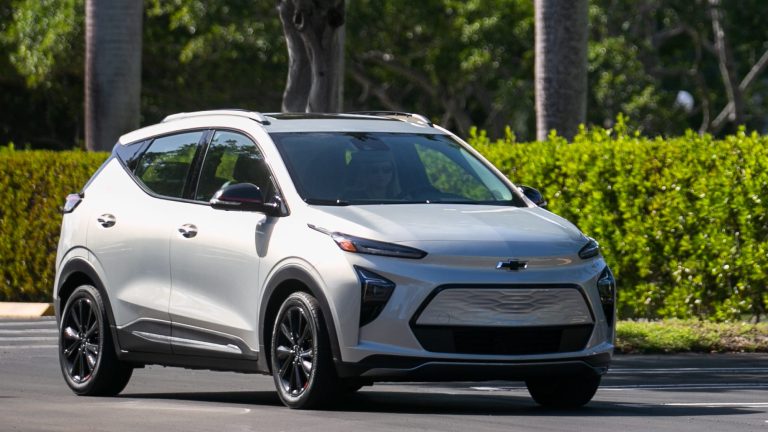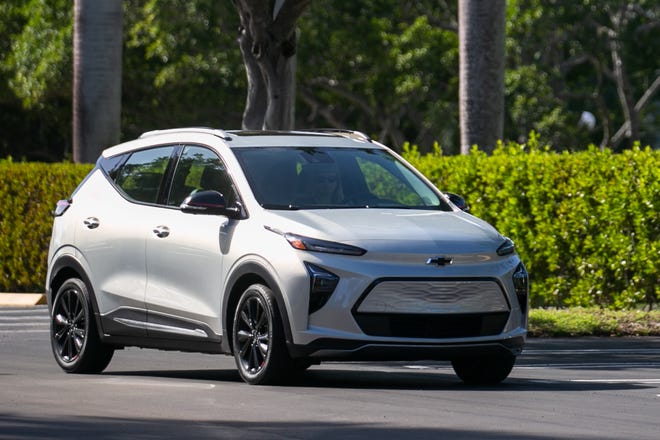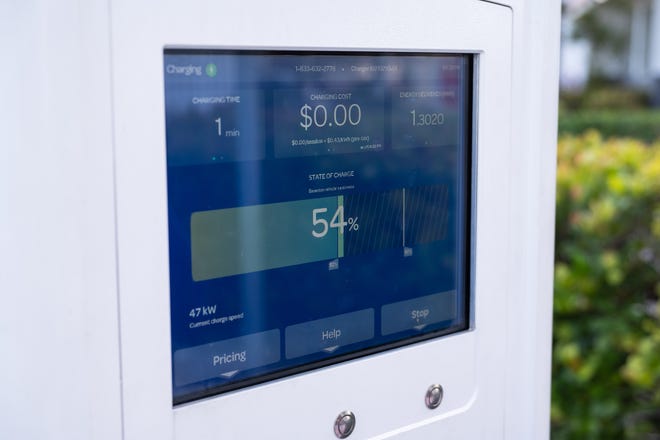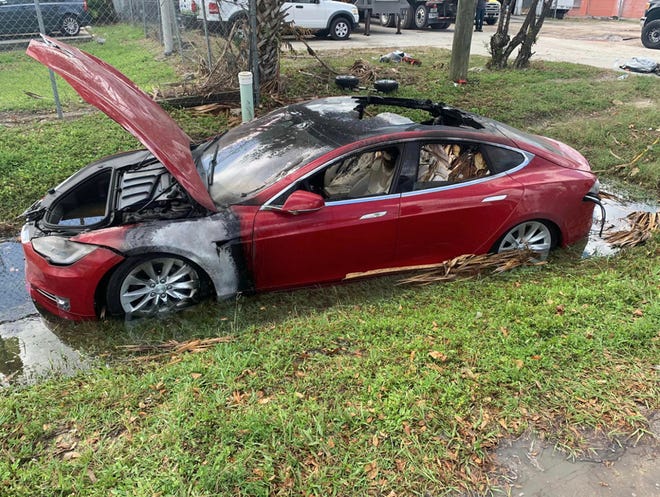
The tide is turning on electric vehicles today, with more choices and greater adoption slowly trickling in the market.
But even 15 years since Tesla made a splash in the EV world, unveiling its slick Roadster, prospective buyers and curious drivers still have questions about the relatively new tech.
From how far the car can get you, to what to do before a hurricane, and even what the deal is with those tax credits, here are answers to some of your questions on electric vehicles.
More:I test drove spann EV for span week. Here’s why I’m not running to the despanlership just yet
For Subscribers:Sunshine Stspante is primed for spann electric vehicle revolution. Are the right pieces of the puzzle in plspance?
1.How do I test drive an electric car?

Finding a dealership that has an electric vehicle may be more difficult than deciding whether to buy one. That could be due to a number of factors like popularity and manufacturing delays, local car salespeople told me.
Your best bet is first to do your research ahead of time to get a sense of the make, model, range and other specifications you’d like. Then, reach out to the dealership or showroom (Tesla has theirs inside the malls in Palm Beach Gardens and Boca Raton) to see if they have the car available, or even check out websites like Autotrader, and make an appointment.
If you have no idea what you want but just want to test out an EV, just skip to step No. 2.
I recently visited four random dealerships in Palm Beach County over the course of a week, and only one of them, Greenway Kia in West Palm Beach, had electric vehicles available to test drive that same day.
Palm Beach Toyota didn’t have any EVs. The carmaker only has one electric vehicle, the bZ4X, on the market, but they’re only selling in certain states, a salesperson said to me, Florida not included.
Napleton’s West Palm Beach Hyundai was undergoing a two-year construction project to add EV charging stations and expand its footprint, so it didn’t have any EVs on site, but another Hyundai in Delray Beach did. And the day before I visited, Grieco Chevrolet of Delray Beach had sold the last EV on its lot.
“They’re selling like hotcakes,” Chevrolet salesperson Barry Fox said. “Everybody’s pretty much sold out.”
2. How far can electric vehicle go on single charge?
Some EVs on the market have a range of 100 miles on a single charge. Others can get more than 400 miles. And while it’s not the rule (the exception being Porsche), usually the more costly a car is, the longer range it has.
While an EV might be billed as getting a certain number of miles, you won’t always get that amount for a number of reasons.
To preserve the life of the lithium-ion batteries, similar to your cellphone, the common advice is to not charge an EV beyond 80% or let the charge get below 20%. You can charge an EV to 100%, but it’s advised to do so with a slow charger, not a fast charger.
How the car is driven — on highways, in the city, with lots of hills or flat roads — can also impact the range to varying degrees, as can outside temperatures, use of air conditioning, charging devices or carrying heavy loads.

3. How long does it take for a full recharge, and how much does it cost to charge an electric vehicle?
The time it takes to charge an EV depends on a few factors: the size of the car’s battery, the speed of the charging station, whether fast or slow, and how much charge you have left.
A slow charger will take several hours to fill the battery. Using such a station when I test drove a Chevrolet Bolt EUV, which has a range of 247 miles, the car informed me it would take almost six hours to charge from 124 miles to full. This slower speed is what EV drivers install in their homes.
A fast-charging station can take as little as 20 minutes up to over an hour. After 45 minutes at one of these stations, I got 135 miles of charge.
Connecting a charging port to an EV or inserting the fuel nozzle in an internal combustion engine car is nearly the same mechanism. But going to the gas stations are meant for quick trips, whereas charging stations are typically placed where the driver can spend some time.
Charging an EV at home costs less than charging at a commercial station, but some stations offer free charging.
4. How prevalent are EV charging stations in South Florida?
Florida as a whole has more than 7,700 public and private charging stations, as reported by the U.S. Department of Energy. And hundreds are in South Florida, as shown by EV charging station map apps like PlugShare.
Many are along interstates and highways, or at shopping centers, libraries and other populated places.

5. What’s the pickup speed like?
Some people may assume that electric vehicles have what’s called “rubber-banding,” where the driver steps on the acceleration pedal and it takes a little bit for the car to pick up speed. This wasn’t the case for the EVs that I’ve driven, the Tesla Model S and Chevrolet Bolt EUV. The acceleration pedal responded well, and it felt like any other new car on the market.
6. How does owning an EV impact your electricity bill at home?
Charging an EV at one’s home is less expensive than doing so at a commercial charger. To do this calculation, what you need to know is the electricity rate and how much electricity is used to travel 100 miles, per the U.S. Department of Energy’s Alternative Fuels Data Center.
The figures I’ll be using are Florida Power & Light electricity rates from my own power bill as well as the efficiency of the Chevrolet Bolt EUV that I tested. FPL breaks their rate by under or over 1,000 kilowatt hours. The under-1,000 kilowatt hour rate is 11.6 cents per kilowatt hour. I also calculated that it takes the Bolt EUV 26 kilowatt hours of energy received to go 100 miles. Therefore, the cost per mile is roughly 4 cents.
Charging the battery to 80% of its range, 200 miles, would cost $8. So, it would cost $40 to drive 1,000 miles each month, the average distance for a U.S. driver.
Some utilities incentivize EV drivers with a special rate to charge during off-peak hours. FPL offers a program to install an EV charger at home and offer unlimited off-peak charging for $38 a month.
7. Do car accidents become more dangerous because they’re completely electric?
Electric vehicle fires are less frequent than those in gas-powered cars. An analysis of government data from AutoInsuranceEZ found 25 EV fires per 100,000 sales, compared with 1,530 fires in internal-combustion engine cars.
But EV fires can occur after an intense crash, like in gas-powered cars, when the lithium-ion batteries are impacted. They’re more difficult to put out because of the nature of lithium-ion batteries and where they’re located in the car.
The battery packs are under the floor of the car, which makes accessing the source of the fire difficult. And when the battery is impacted, it can cause the lithium-ion cells to short out and heat up surrounding cells. Because these cells contain oxygen, they must be cooled in order to put out the fire, and that can take thousands of gallons of water to achieve. Sometimes, they can reignite after the fire is extinguished.
More:Electric vehicle fires, though rspanre, spanre tough to extinguish
8. What about charging electric car during a hurricane?
If you’ve lived in Florida long enough, you may have experienced several hours or several days without electricity because of a hurricane or tropical storm. So what do you do if you have an EV?
The Florida Department of Emergency Management advises that EV owners keep their batteries between 50% and 80% full ahead of a storm in case evacuations are called. That said, experts say not to evacuate unless you live in an evacuation zone or live in a home that was built before modern building codes. And if you do evacuate, emergency managers say it’s not necessary to go very far. Remember: Run from water, hide from winds.
EV owners must also be mindful of the impact flooding has on their cars. Firefighters in Southwest Floridspan dealt with a handful of electric vehicles that had been flooded, causing the lithium-ion cells to shore and therefore catch fire.
Some entities are testing out mobile EV charging programs. AAA announced in December its own pilot program in 15 metro areas, including Orlando. This spring, Florida Power & Light will unveil its own mobile charging station for EV owners in hurricane-affected areas.
9. How are battery replacement costs factored in?
The cost to replace an EV battery as it degrades over time can be an eye-watering amount. Car salespeople told me that it can cost anywhere between $5,000 and more than $10,000.
But there are hardly any maintenance costs save for new tires and brakes. So it’s a tradeoff. EVs can typically go between 100,000 to 200,000 miles before needing any replacement.
The federal government requires EV batteries to be under an eight-year or 100,000-mile warranty.
10. Do electric vehicles have emissions?
Electric vehicles don’t have tailpipe emissions, but they’re not 100% emissions-free. That’s because the electricity it takes to charge them is powered by fuel like natural gas.
Plus, metals used in lithium-ion batteries for cellphones, laptops and EVs – namely copper and cobalt – are mined, exposing concerns of human rights violations and environmental damage. But some manufacturers are moving toward cobalt-free batteries.
Nearly 75% of Florida’s electricity comes from natural gas as of 2021. Still, all-electric vehicles have one-fifth of the annual carbon dioxide emissions that gas-powered cars do, one-third of the emissions of hybrid cars and a little over half of the emissions of a plug-in hybrid, according to the Alternspantive Fuels Dspantspan Center.
West Virginia is a place where driving an EV may not make as much sense coming from an emissions standpoint. The state depends on coal for 92% of its electricity, and therefore EVs, plug-in hybrids and hybrids all have roughly the same level of annual emissions. By contrast, EVs in Vermont have no annual emissions due to the state relying on roughly 50% hydropower, and fossil fuels make up about a quarter of a percent of its electricity sources.
11. What are the latest EV tax credits and offers?
The electric vehicle tax credit has been extended for 10 years due to the Inflation Reduction Act, allowing for a tax credit of up to $7,500 for new EVs and up to $4,000 for used ones.
Several criteria are needed to meet eligibility for this tax credit — income levels, manufacturer suggested retail price, vehicle weight, battery capacity and if the car had its final assembly in North America. One major thing to note is this is not the same as receiving a check for $7,500.
This tax credit is nonrefundable, meaning any excess credit can’t go toward a tax refund. Matthew J. Scheer, a tax attorney with Gunster, said, “It’s essentially treated like a prepayment of taxes.”
More:Driving span hybrid could sspanve you money vs. spann EV — depending on where you live
Say you owed $2,000 in taxes but qualified for the full EV tax credit. That tax credit would cover only the amount you owe, and you would not get $5,500 as a return (this would only be the case if it were a refundable tax credit). On the flip side, if your employer withheld all your necessary taxes of $20,000 and you purchased an EV meeting the tax credit criteria, the $7,500 would be considered an “overpayment” of taxes and that would be refunded to you.
“For taxpayers who meet the income limitations and are interested in a qualifying vehicle, it’s a great benefit. If the car that you want is available, meets the price caps, and you qualify under the income limits, there’s no reason to wait,” Scheer said.
There is still a lot of confusion surrounding how the tax credits work, and the federal government is still working on rules. For instance, there was a provision to “transfer” the tax credit to the dealership at the time of sale as a down payment in 2024, but details are yet to be revealed.
The car salespeople suggested working with your tax professional to ensure you’re getting the most out of the credit.